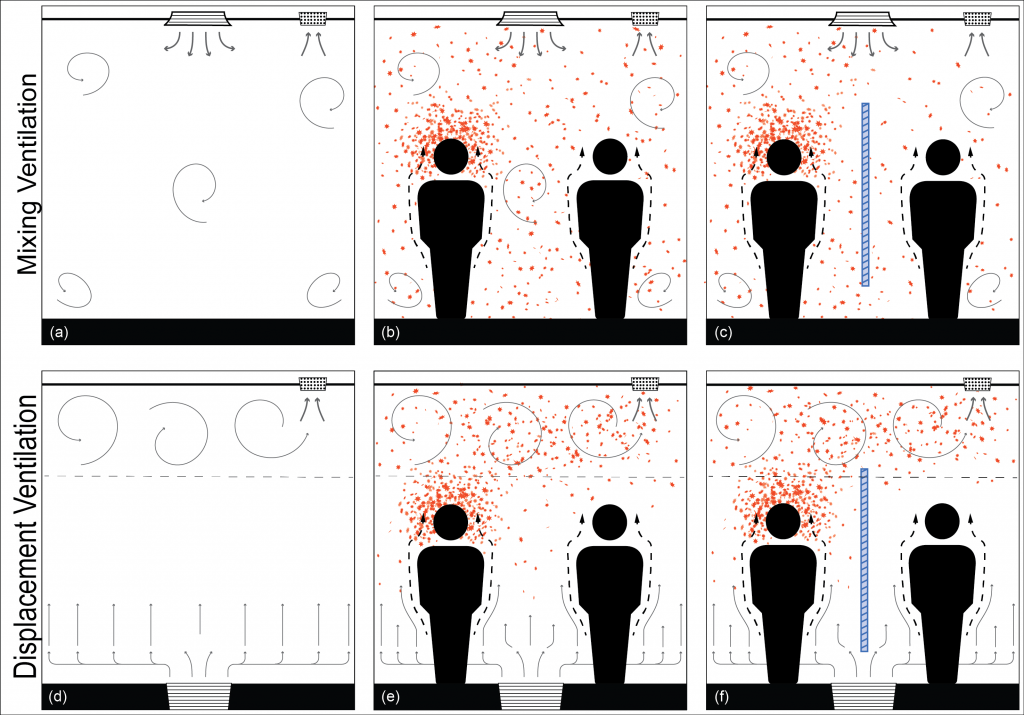Reported by Kerrie Marshall, Arik Palileo and Eric A. Schiff
Download the PDFThis brief was updated on February 19, 2021.
Key Findings
- Semi-open partitions can reduce airborne disease transmission when combined with a proper ventilation flow pattern in the room.
- With ordinary “mixing ventilation”, well-designed, semi-open partitioned space can reduce the infection risk by 2 to 3 times.
- With advanced ”displacement ventilation”, semi-open partitioned space reduce the risk by at least 4 times, and more with optimized designs.
The novel Coronavirus (SARS CoV-2), which causes the respiratory illness COVID-19, is readily transmitted from infected people who have no signs of infection. Airborne virus-containing particles exhaled from individuals speaking, breathing, or coughing are considered a significant source of spread for COVID-19. There are several well-known measures that reduce risk: masks for all individuals, increased ventilation through the central system or windows, and portable air purifiers.
This brief summarizes two more measures that work by modifying how air flows within a room. These have been studied by Meng Kong and Jianshun “Jensen” Zhang, who are Syracuse University faculty affiliated with SyracuseCoE. They distinguish between common “mixing” ventilation systems and less common “displacement” ventilation systems. The latter are superior at reducing transmission of disease from an infected person to other occupants of a room. Semi-open partitions can be installed in existing offices and classrooms that also reduce disease transmission when combined with a proper ventilation flow pattern in the room. An important virtue of the partitions is that they are a passive disease control measure, and don’t increase the operating cost of a building.
Mixing Ventilation
Most indoor spaces are fitted with mixing ventilation. This system uses vents, typically located near ceiling level, to pump clean, conditioned air into the room at high velocity. The clean air mixes with existing air in the room near the ceiling, called the mixing zone, before reaching an individual’s area. The airflow is illustrated in panel (a) of the figure. When an infected person is exhaling virus particles, they are spread fairly uniformly through the room, as illustrated in panel (b).
Partitions can reduce the lateral spread of virus between sections. They can be made inexpensively from clear plastic panels. Virus particles tend to rise until reaching a mixing zone above the partitions, as seen in panel (c). Kong & Zhang calculate that these partitions can reduce the risk of infection by 2 to 3 times below the baseline risk. The precise risk reduction factor depends on the location of the air supply and the exhaust in relation to an individual’s workspace.

Displacement Ventilation
The second, less common ventilation system is displacement ventilation. In displacement ventilation, vents in the floor slowly bring cool, conditioned clean air into the room that blankets the room floor. This is illustrated in panel (d). As the air is heated by a person’s body, it becomes a thermal plume that rises towards the ceiling along with exhaled virus. The effect is illustrated in panel (e). A return vent in the ceiling then removes air from the room before it mixes with air at lower levels.
Displacement ventilation on its own can substantially reduce the spread of exhaled virus in workspaces adjoining that of an infected person, as is illustrated in Panel (e). Describing ongoing research, Jensen Zhang says the reduction may be as large as tenfold for optimized displacement ventilation designs. In conjunction with semi-open partitions, the risk reduction may reach 20 times, as illustrated in panel (f).
References
Jensen Zhang (2020). “Integrating IAQ control strategies to reduce the risk of asymptomatic SARS CoV-2 infections in classrooms and open-plan offices”, Science and Technology for the Built Environment, 26:8, 1013-1018, DOI: 10.1080/23744731.2020.1794499
Meng Kong (2017). “Semi-Open Space and Micro-Environmental Control for Improving Thermal Comfort, Indoor Air Quality, and Building Energy Efficiency”, Dissertations – ALL. 810.
https://surface.syr.edu/etd/810
